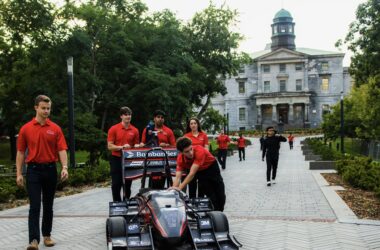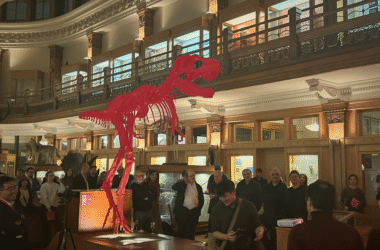The ‘Vanishing Indian’ myth—the idea that Indigenous populations are destined to disappear— has long been used to excuse and enact the physical and cultural genocide of Indigenous Peoples in the Americas. This rhetoric remains prevalent in modern genomics, often supporting the treatment of modern Indigenous Peoples not as autonomous communities, but as research subjects from which information about the past can be extracted.
On Nov. 7, at the 48th Annual Osler Lectureship, Kim TallBear, a Sisseton Wahpeton Oyate professor of American Indian Studies from the University of Minnesota, presented her critique of modern human genomic science and its tendency to reproduce the narrative that Indigenous Peoples are ‘vanishing.’ In her research, she argues that modern genetics often undermines Indigenous Peoples’ own conceptions of their tribes and histories by favouring a Eurocentric, genetic-based identity.
She began by outlining the historical roots of this perspective, showing how it became associated with evolutionary ideas of ‘fitness.’
“In conjunction with Indian removal [in the 19th century], popular American imagery began to play on earlier symbolic linkages between Indians and the past, and these images eventually produced the full-blown ideology of the vanishing Indian, which proclaimed that a less advanced society should disappear in the presence of those more advanced,” TallBear said.
She showed how the Genographic Project—a study aiming to map humans’ movement across the Earth by gathering large amounts of DNA, conducted from 2005 to 2019—exemplified this. It claimed that ‘isolated’ Indigenous DNA was hard to gather because Indigenous cultures were “quickly vanishing into a 21st-century global melting pot.”
TallBear then explained a fundamental difference in how Indigenous Peoples and Western science discuss and understand Indigeneity. She shared that most Indigenous people talk about their identity in explicitly political ways that push back against an assimilative state and emphasize their rights to govern the lands that we live on. They stress the continuity and ongoing connection between pre-colonial societies, modern people, and future generations.
She noted, however, that science attempts to separate itself from social and political relationships, while remaining implicitly political. Western science frames identity and populations as static, treating Indigenous people as a part of history. While ignoring the notions of kinship, culture, and relationship with land that Indigenous Peoples use to define themselves, science aims to categorize Indigenous tribes and populations purely by genetic ancestry.
“When Indigenous Peoples talk about connection to ancestors and to place, we’re doing it in a way that’s talking about our ongoing continuity [….] But with this [scientific] idea of autochthony, originating where found, this implies stasis,” she said. “So this is really the opposite of the way Indigenous people are using that connection to ancestors [….] Genome scientists use this category [of Indigenous] in a way that assumes and is supported by the assimilative state.”
Tallbear used several examples to support this, one of them being the discovery of the Kennewick Man skull in 1996 in Washington. Although the skull was dated to be 9,000 years old, it took almost 20 years of genetic testing and legal battles for the skull to be identified as legally belonging to the five Native American tribes in the area.
“[Some scientists] said that despite the antiquity of the remains, there wasn’t sufficient evidence to link the ‘Ancient One,’ or Kennewick Man, to living tribes [today],” she said.
It was not until scientist Eske Willerslev gathered DNA from one of the tribes and showed the direct genetic link between them and the Kennewick Man that the tribes got legal rights to bury the skull.
TallBear concluded her talk by discussing her new research directions and involvement with the organization Summer Internships for Indigenous Peoples in Genomics (SING), which teaches young Indigenous scientists to connect scientific education with Indigenous knowledge and governance.
“A lot of young Indigenous scientists or aspiring scientists may be in great programs and getting really good training, but they’re not taught how to contextualize this within Indigenous governance [….] All nations live governed by science, and that includes Indigenous nations,” she said.
TallBear reminds us that scientific knowledge production does not exist outside of political and social structures. These lessons can help young genomic scientists view research methods and implications critically, and to chart new, more equitable and thoughtful paths in science, just as she has done.






